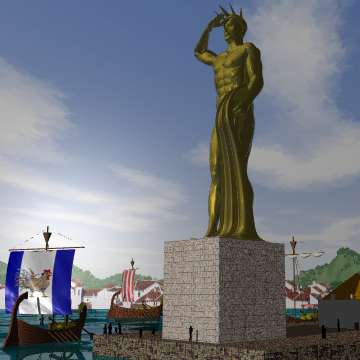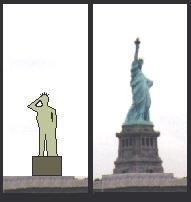The Colossus of Rhodes

The Colossus
stood at the harbour entrance
Travellers to New York City harbour see
a marvellous sight. Standing on a small island in the harbour is an
immense statue of a robed woman, holding a book and lifting a torch to the
sky. The statue measures almost one-hundred and twenty feet from foot to
crown. It is sometimes referred to as the "Modern Colossus," but more
often called the Statue of Liberty.
This awe-inspiring statue was a gift
from France to America and is easily recognized by people around the
world. What many visitors to this shrine to freedom don't know is that the
statue, the "Modern Colossus," is the echo of another statue, the original
colossus that stood over two thousand years ago at the entrance to another
busy harbour on the Island of Rhodes. Like the Statue of Liberty, this
colossus was also built as a celebration of freedom. This amazing statue,
standing the same height from toe to head as the modern colossus, was one
of the Seven Wonders of the Ancient World.
The island of Rhodes was an important
economic centre in the ancient world. It is located off the South-western
tip of Asia Minor where the Aegean Sea meets the Mediterranean. The
capitol city, also named Rhodes, was built in 408 B.C. and was designed to
take advantage of the island's best natural harbour on the northern coast.
In 357 B.C. the island was conquered by
Mausolus of Halicarnassus (whose tomb is one of the other Seven Wonders of
the Ancient World), fell into Persian hands in 340 B.C., and was finally
captured by Alexander the Great in 332 B.C.. When Alexander died of a
fever at an early age, his generals fought bitterly among themselves for
control of Alexander's vast kingdom. Three of them, Ptolemy, Seleucus, and
Antigous, succeeded in dividing the kingdom among themselves.
The Rhodians supported Ptolemy (who
wound up ruling Egypt) in this struggle. This angered Antigous who sent
his son Demetrius to capture and punish the city of Rhodes.
The war was long and painful. Demetrius
brought an army of 40,000 men. This was more than the entire population of
Rhodes. He also augmented his force by using Aegean pirates.
The city was protected by a strong,
tall, wall and the attackers were forced to use siege towers to try and
climb over it. Siege towers were wooden structures often armed with
catapults that could be moved up to a defender's walls to allow the
attackers to scale them. While some were designed to be rolled up on land,
Demetrius used a giant tower mounted on top of six ships lashed together
to make his attack. This tower, though, was turned over and smashed when a
storm suddenly approached. The battle was won by the Rhodians.
Demetrius had a second super-tower
built. This one stood almost 150 feet high and some 75 feet square at the
base. It was equipped with many catapults and skinned with wood and
leather to protect the troops inside from archers. It even carried water
tanks that could be used to fight fires started by flaming arrows. This
tower was mounted on iron wheels and could be rolled up to the walls.
When Demetrius attacked the city, the
defenders stopped the war machine by flooding a ditch outside the walls
and miring the heavy monster in the mud. By then almost a year had gone by
and a fleet of ships from Egypt arrived to assist the city. Demetrius
withdrew quickly leaving the great siege tower where it was.
To celebrate their victory and freedom,
the Rhodians decided to build a giant statue of their patron god Helios.
They melted down bronze from the many war machines Demetrius left behind
for the exterior of the figure and the super siege tower became the
scaffolding for the project. According to Pliny, a historian who lived
several centuries after the Colossus was built, construction took 12
years. Other historians place the start of the work in 304 B.C..
The statue was one hundred and ten feet
high and stood upon a fifty-foot pedestal near the harbour mole. Although
the statue has been popularly depicted with its legs spanning the harbour
entrance so that ships could pass beneath, it was actually posed in a more
traditional Greek manner: nude, wearing a spiked crown, shading its eyes
from the rising sun with its right hand, while holding a cloak over its
left.
No ancient account mentions the
harbour-spanning pose and it seems unlikely the Greeks would have depicted
one of their gods in such an awkward manner. In addition, such a pose
would mean shutting down the harbour during the construction, something
not economically feasible.
The statue was constructed of bronze
plates over an iron framework (very similar to the Statue of Liberty which
is copper over a steel frame). According to the book of Pilon of
Byzantium, 15 tons of bronze were used and 9 tons of iron, though these
numbers seem low. The Statue of Liberty, roughly of the same size, weighs
225 tons. The Colossus, which relied on weaker materials, must have
weighed at least as much and probably more.
Ancient accounts tell us that inside the
statue were several stone columns which acted as the main support. Iron
beams were driven into the stone and connected with the bronze outer skin.
Each bronze plate had to be carefully cast then hammered into the right
shape for its location in the figure, then hoisted into position and
riveted to the surrounding plates and the iron frame.

Comparing the Statue of Liberty with the Colossus:
Though the bodies are the same size the Statue stands higher because of
the taller pedestal and upraised torch.
The architect of this great construction
was Chares of Lindos, a Rhodian sculptor who was a patriot and fought in
defence of the city. Chares had been involved with large scale statues
before. His teacher, Lysippus, had constructed a 60-foot high likeness of
Zeus. Chares probably started by making smaller versions of the statue,
maybe three feet high, then used these as a guide to shaping each of the
bronze plates of the skin.
It is believed Chares did not live to
see his project finished. There are several legends that he committed
suicide. In one tale he has almost finished the statue when someone points
out a small flaw in the construction. The sculptor is so ashamed of it he
kills himself.
In another version the city fathers
decide to double the height of the statue. Chares only doubles his fee,
forgetting that doubling the height will mean an eightfold increase in the
amount of materials needed. This drives him into bankruptcy and suicide.
There is no evidence that either of
these tales are true.
The Colossus stood proudly at the
harbour entrance for some fifty-six years. Each morning the sun must have
caught its polished bronze surface and made the god's figure shine. Then
an earthquake hit Rhodes and the statue collapsed. Huge pieces of the
figure lay along the harbour for centuries.
"Even as it lies," wrote Pliny, "it
excites our wonder and admiration. Few men can clasp the thumb in their
arms, and its fingers are larger than most statues. Where the limbs are
broken asunder, vast caverns are seen yawning in the interior. Within it,
too, are to be seen large masses of rock, by the weight of which the
artist steadied it while erecting it."
It is said that an Egyptian king offered
to pay for its reconstruction, but the Rhodians refused. They feared that
somehow the statue had offended the god Helios, who used the earthquake to
throw it down.
In the seventh century A.D. the Arabs
conquered Rhodes and broke the remains of the Colossus up into smaller
pieces and sold it as scrap metal. Legend says it took 900 camels to carry
away the statue. A sad end for what must have been a majestic work of art.
Top of page

|